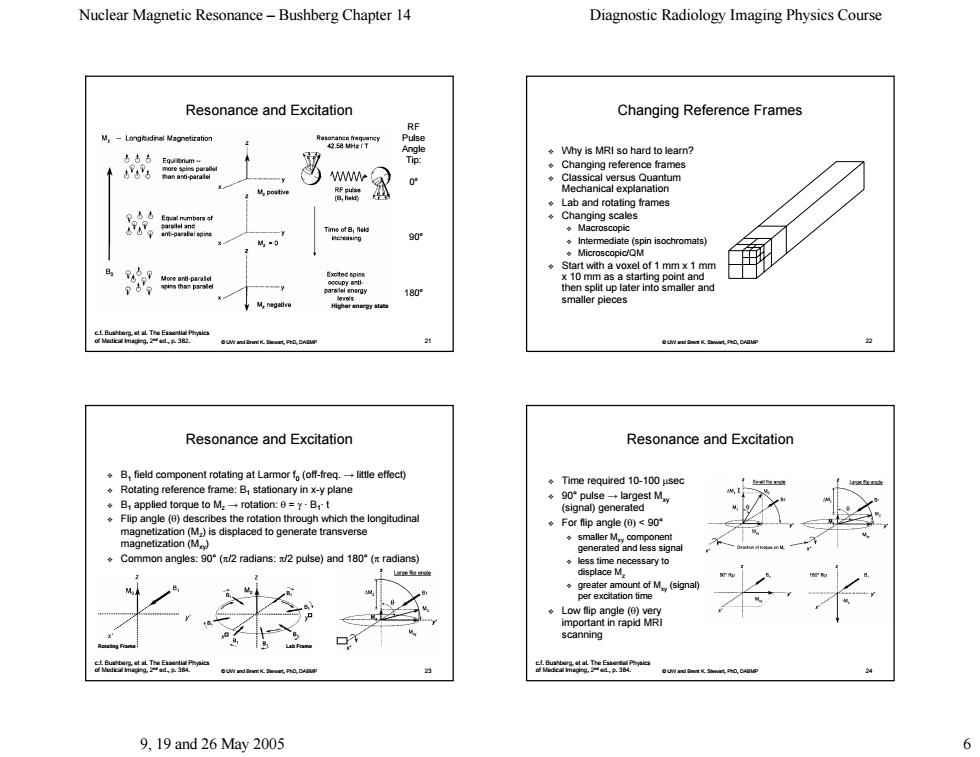正在加载图片...

Nuclear Magnetic Resonance-Bushberg Chapter 14 Diagnostic Radiology Imaging Physics Course Resonance and Excitation Changing Reference Frames M-Longhudinal Magetization 67 E .Why is MRI so hard to learn? .Changing reference frames M Classical versus Quantum 胎 Mechanical explanation .Lab and rotating frames 成 ◆Changing scales 品 。Macroscopic Intermediate(spin isochromats) mm 马家 ha vo 180 then split up later into smaller and smaller pieces 4a Resonance and Excitation Resonance and Excitation .B,field component rotating at Larmor f (off-freg.-litle effect) Time required 10-100 usec .Rotating reference frame:B,stationary in x-y plane B,applied torque to Mrotation:B ◆90°pulse一largest My (signal)generated describes the on th ◆For flip angle(g<90 。smaller M gneri Common angles:90(/2 radians:/2 pulse)and 180(radians) ◆less time necessary to displace M 9,19and26May2005 6 Nuclear Magnetic Resonance – Bushberg Chapter 14 Diagnostic Radiology Imaging Physics Course 9, 19 and 26 May 2005 6 © UW and Brent K. Stewart, PhD, DABMP 21 Resonance and Excitation c.f. Bushberg, et al. The Essential Physics of Medical Imaging, 2nd ed., p. 382. RF Pulse Angle Tip: 0° 90° 180° Higher energy state © UW and Brent K. Stewart, PhD, DABMP 22 Changing Reference Frames Changing Reference Frames Why is MRI so hard to learn? Changing reference frames Classical versus Quantum Classical versus Quantum Mechanical explanation Lab and rotating frames Changing scales Macroscopic Intermediate (spin Intermediate (spin isochromats) Microscopic/QM Start with a voxel of 1 mm x 1 mm Start with a voxel of 1 mm x 1 mm x 10 mm as a starting point and x 10 mm as a starting point and then split up later into smaller and then split up later into smaller and smaller pieces © UW and Brent K. Stewart, PhD, DABMP 23 Resonance and Excitation B1 field component rotating at Larmor f field component rotating at Larmor f0 (off-freq. → little effect) little effect) Rotating reference frame: B1 stationary in x-y plane B1 applied torque to applied torque to Mz → rotation: rotation: θ = γ · B1· t Flip angle ( Flip angle (θ) describes the rotation through which the longitudinal ) describes the rotation through which the longitudinal magnetization (Mz) is displaced to generate transverse ) is displaced to generate transverse magnetization (Mxy) Common angles: 90° (π/2 radians: /2 radians: π/2 pulse) and 180° (π radians) radians) c.f. Bushberg, et al. The Essential Physics of Medical Imaging, 2nd ed., p. 384. Rotating Frame Lab Frame © UW and Brent K. Stewart, PhD, DABMP 24 Resonance and Excitation Time required 10-100 µsec 90° pulse → largest Mxy (signal) generated For flip For flip angle ( angle (θ) < 90° smaller Mxy component component generated and less signal generated and less signal less time necessary to less time necessary to displace Mz greater amount of greater amount of Mxy (signal) (signal) per excitation time Low flip Low flip angle (θ) very important in rapid MRI important in rapid MRI scanning c.f. Bushberg, et al. The Essential Physics of Medical Imaging, 2nd ed., p. 384